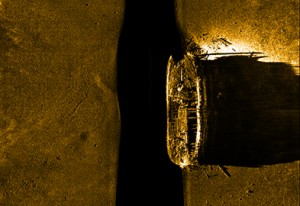Major discovery in historic Franklin Expedition

Overhead image showing what appears to be a well-preserved ship. Source: Parks Canada
When two ships and all the crew of the Franklin Expedition went missing in the Arctic back in the late 1840s, a massive search and rescue effort ensued, to no avail.
The mystery has fascinated researchers and the lay public ever since. In 2008 Canada resumed the hunt to find the expedition’s lost ships with considerable effort and media attention.
On Tuesday (Sept 9) Prime Minister Stephen Harper announced the discovery of one of the long-sought lost ships.
As stated in the official press release:
“Although we do not know yet whether the discovery is Her Majesty’s Ship (HMS) Erebus or HMS Terror, we do have enough information to confirm its authenticity. This find was confirmed on Sunday, September 7, 2014, using a remotely operated underwater vehicle recently acquired by Parks Canada.”
Full details on the location of the find were not immediately released. One source quoted John Geiger of the Royal Canadian Geographic Society as indicating the vessel was discovered in “…about 36 feet below the surface in Queen Maud Gulf, off the Nunavut mainland, about 1,800 miles north of Toronto.” (Note: I include that “where” quote for curiosity’s sake, the specifics require further official confirmation.)
Here’s more coverage from Canadian Press and the CBC. And here’s how the news was covered by the BBC:
The find has been described as “the biggest archaeological discovery the world has seen since the opening of Tutankhamun’s tomb almost 100 years ago” by a British archaeologist, William Battersby, who has written extensively about the Franklin expedition.
“From the images it is clear that a huge amount of evidence will be preserved from the expedition, possibly even including the remains of the men and maybe, just possibly, some of their photographs,” he said.
The loss of HMS Erebus and HMS Terror, which was built in Topsham, Devon, prompted one of largest searches in history, running from 1848 to 1859.
The mystery has gripped people for generations, in part because no one knows for sure exactly what happened to the crew.
This story gets far more press in Canada and the UK, because of the ties those nations have to the event, and (to some degree) because of the Prime Minister’s strong personal interest in the search. CBC news anchor Peter Mansbridge penned an essay on why he and others care about something over and done so long ago.
This isn’t just a story of looking for old bones and old bits of ship — it’s a story about us, about our country, about our history.
Are there more important things to be studying, researching and looking for?
Of course.
But this is a pretty good one, too, and this week’s news is exciting — Canadians have found what many others couldn’t, and we’ve unlocked yet another part of our own story.
I’ve written about the hunt and its appeal in several previous In Box posts. It’s just a great “and then what happened?” yarns.
Ian Austen covers Canada for the New York Times. His article of Sept 9 summarizes some of the political and archeological aspects of the discovery:
John Geiger, the president of the Royal Canadian Geographical Society, one of the groups that participated in the search, said that images showed that the ship appeared to be very well preserved. He said he expected that divers would eventually recover artifacts that further detail the expedition’s ordeal.
“It’s not just that the ships are interesting historical artifacts,” he said. “They hold answers to questions that have long been unanswered.”
Clearly, there will be far more to come on this discovery, and one more ship to find, if possible. Here’s a link to more from Parks Canada, including a photo galley and video.
As reported by CBC, the search was conducted by “a partnership between Parks Canada, the Royal Canadian Geographical Society, the Arctic Research Foundation, the Canadian Coast Guard, the Royal Canadian Navy and the government of Nunavut.”
Tags: Arctic, canada, Franklin Expedition, history, Northwest Passage, Parks Canada, politics







